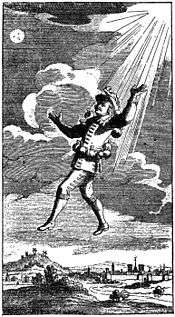Comical History of the States and Empires of the Moon

The Other World: Comical History of the States and Empires of the Moon (L’Autre monde ou les états et empires de la Lune) was the first of three satirical novels written by Cyrano de Bergerac, that are considered among the first science fiction stories. Arthur C Clarke credited this book with being the first example of a rocket-powered space flight, and for inventing the ramjet.[1] It was published after the author's death, in 1657.
Plot summary
Cyrano narrates the book in the first person through a narrator also named Cyrano, as if relating his own travels.
In part one, an attempt to reach the Moon to prove there is a civilization that views Earth as its moon leads the narrator to soar from Paris into the sky by strapping bottles of dew to his person, but he fails and lands back on Earth. Believing to have traveled straight up and down, he is confused by local soldiers who tell him he is in France; they escort him to the provincial governor who informs him that it is in fact New France. The narrator explains to the governor that all matter is formed inside and expelled from stars, and that once the Sun has run out of fuel it will consume the planets and restart the cycle. He uses New France as evidence for this theory, claiming that its only being discovered not long ago by European explorers was because the Sun had only recently sent it to Earth.
The narrator tries again to construct a way of reaching the Moon, this time through a flying machine that he launches off a cliff's edge. Though the craft crashes, local soldiers attach rockets to it, hoping that it will fly to celebrate the feast day of St. John the Baptist. Dismayed at this use of his machine, the narrator attempts to deconstruct it while the fuse is lit, but the machine takes off and sends him into space. He meets inhabitants who have four legs, musical voices, and amazing weapons that cook game for a meal while it's being shot, as well as the ghost of Socrates and Domingo Gonsales of Francis Godwin's The Man in the Moone. His discussions with Gonsales include how useless of a concept God is, that humans cannot achieve immortality, and that they do not have souls. After these discussions, the narrator returns to Earth.
In part two, a new machine that focuses solar energy through mirrors to generate bursts of air sends the narrator to the Sun. Those living on a Sun spot teach him about the solar system by relating it to how atoms move. Upon the surface of the Sun, he is tried for all the crimes humanity has committed by birds, but one who knows him sets him free. The narrator then discusses with Tommaso Campanella how sex would work in Utopia.
Impact
Inspired by Lucian's proto-science fiction work True History or True Story, The Other World went on to influence many other works seen as early science fiction, including Jonathan Swift's novel Gulliver's Travels, which is also an example of fantastic voyages exploring both contemporary social commentary, and some ideas of the unknown and "modern" science.
The French comic book series De cape et de crocs, created by writer Alain Ayroles and artist Jean-Luc Masbou, draws inspiration from The Other World and makes frequent references to the work and its author.
See also
References
- ↑ Petri Liukkonen. "Savien Cyrano de Bergerac (1619-1655)". Books and Writers (kirjasto.sci.fi). Archived from the original on 4 July 2013.
External links
| French Wikisource has original text related to this article: |
- Cyrano de Bergerac (1889). Curtis Hidden Page, ed. A Voyage to the Moon. Translated by Archibald Lovell. New York: Doubleday and McClure Co. Retrieved 5 April 2015.
- Additional copies: 1 2 3
 A voyage to the Moon public domain audiobook at LibriVox
A voyage to the Moon public domain audiobook at LibriVox